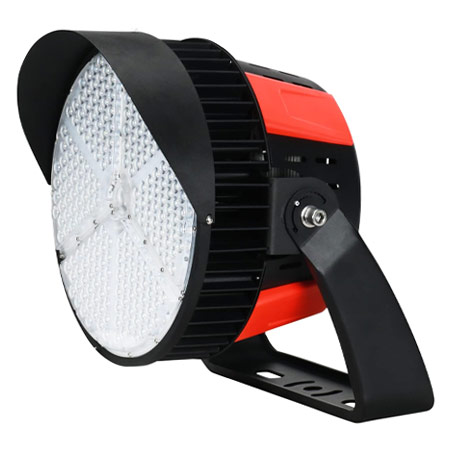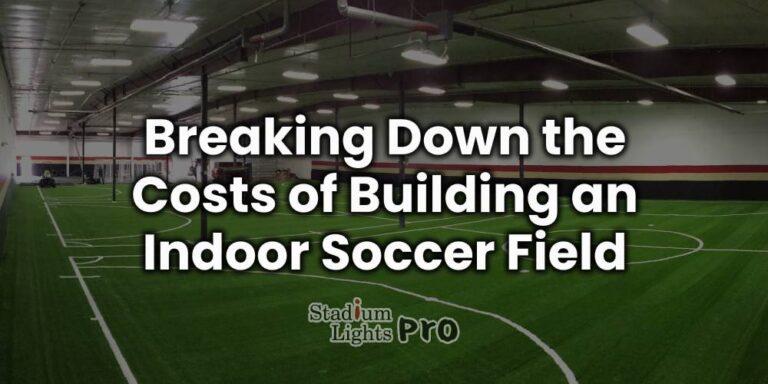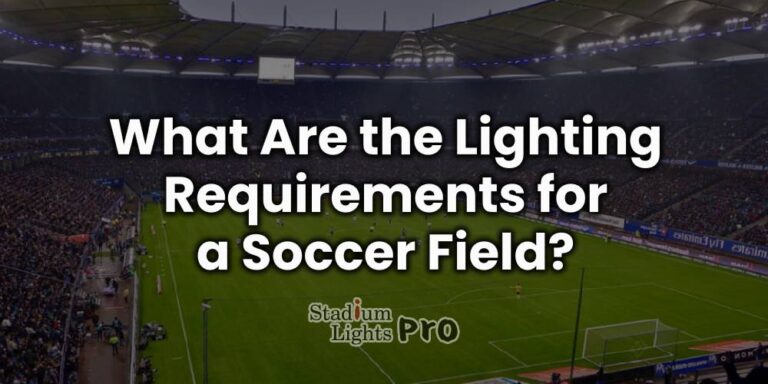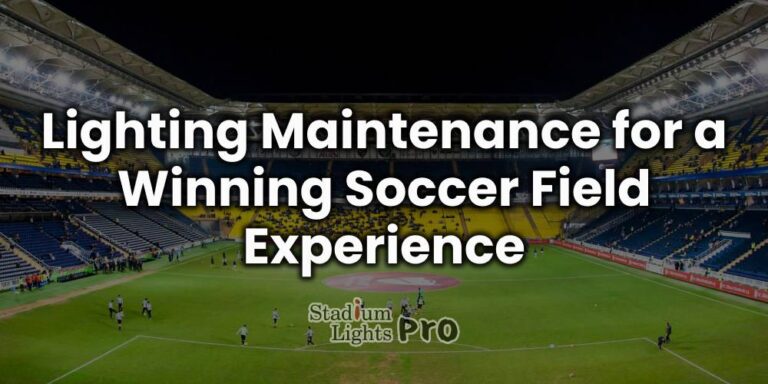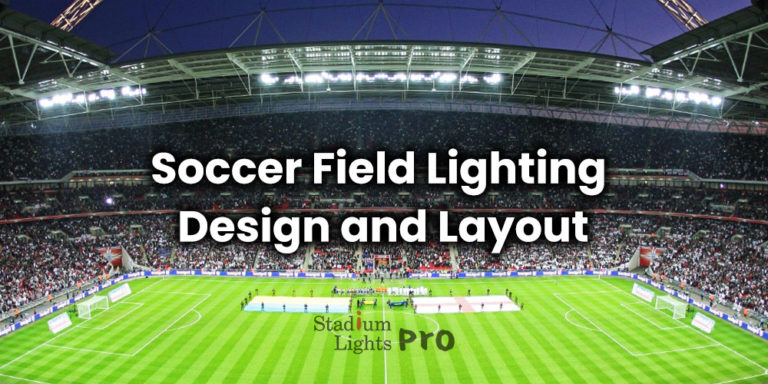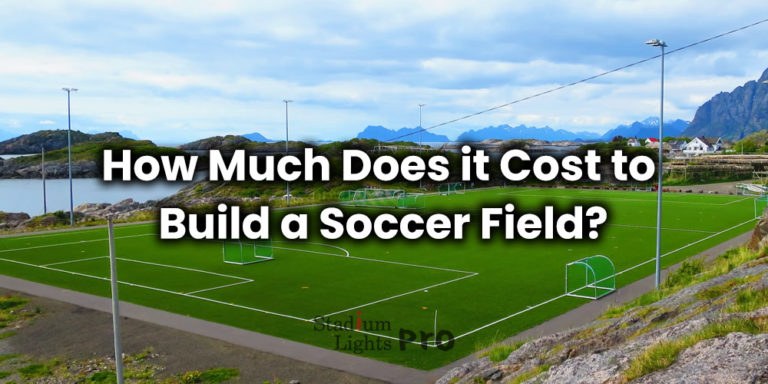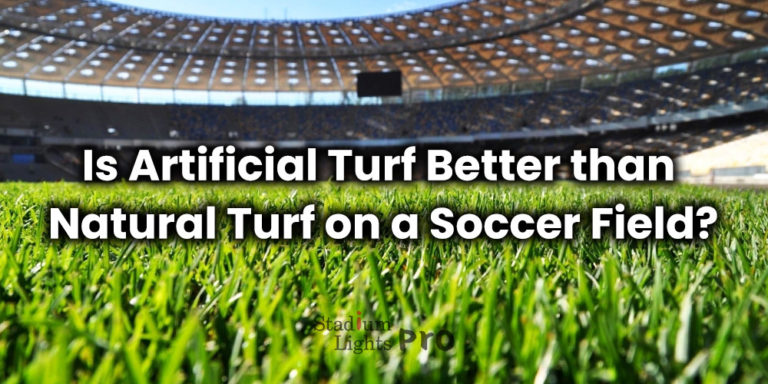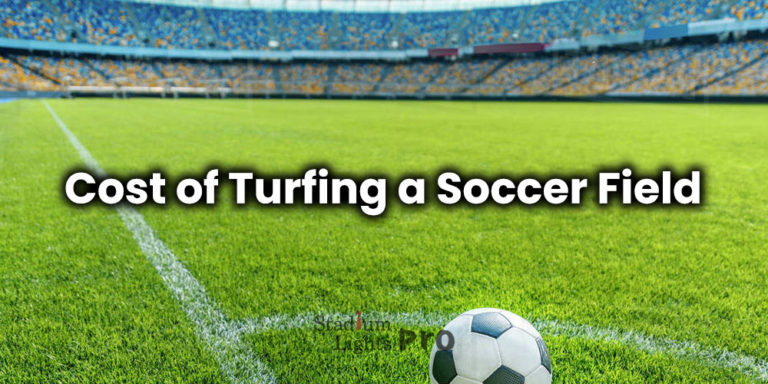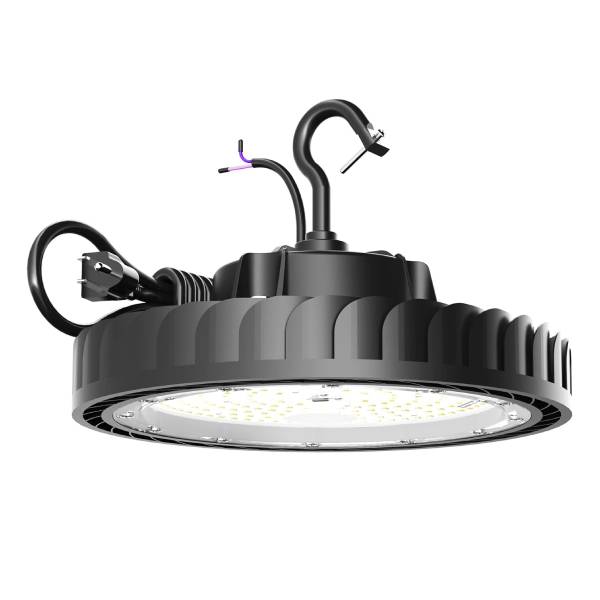
Soccer Field Lighting
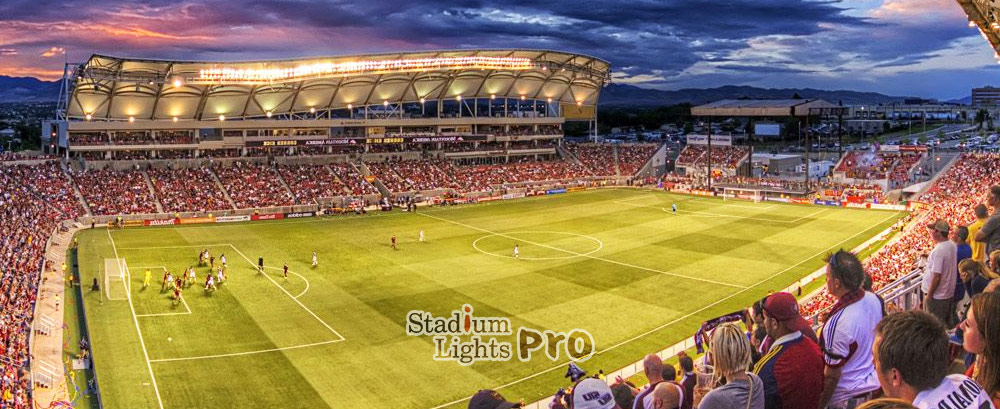
Welcome to our comprehensive guide on soccer field lighting! Here, you will discover a wealth of valuable information on how to effectively light up your soccer pitch or stadium. Whether you are a facility manager, soccer field owner, or simply interested in the subject, this article is packed with essential knowledge that will help you make informed decisions about your lighting needs.
As you navigate through this guide, you will learn about the different factors to consider when selecting soccer field lighting, such as the required levels of illuminance for various levels of play, lighting uniformity and glare control, energy efficiency and sustainability, maintenance and durability, as well as cost considerations. We will also explore the various types of lighting systems available for soccer fields, including metal halide, LED, induction, and fluorescent lighting. We will discuss the pros and cons of each type and help you decide which is best suited for your unique needs.
We understand that installing and maintaining a soccer field lighting system can be a complex process. Therefore, we will provide you with expert advice on selecting the right installation team and contractor, as well as proper maintenance procedures and schedules. We will also discuss the benefits of upgrading and replacing older lighting systems.
Contact us for a free lighting consultation
Table of Contents
ToggleWhat are soccer field lights?
Soccer field lighting refers to the use of artificial lighting systems to illuminate soccer fields during outdoor games and events. Adequate lighting is essential for players, officials, and spectators to see and participate in the game safely and effectively. A well-lit soccer field can enhance the overall experience for players, coaches, and fans and contribute to the success of sporting events.
Brief history of soccer field lighting
The history of soccer field lighting dates back to the early 20th century when electric lights were first used to illuminate sporting events. At first, the lighting systems were basic and inefficient, with low wattage bulbs that provided minimal illumination. However, as technology advanced, the lighting systems became more sophisticated, with higher wattage bulbs and better illumination. Today, soccer field lighting has become an integral part of the sports industry, with a variety of lighting options available for different types of fields and events.
In recent years, advancements in technology have made soccer field lighting more efficient, sustainable, and cost-effective. Modern lighting systems can be tailored to meet the specific needs of each field and event, providing a high level of illumination while minimizing energy consumption and maintenance costs. As a result, soccer field lighting has become an essential part of sports facilities, allowing for longer playing hours and more exciting events.
Factors to consider when selecting soccer field lighting
Illuminance requirements for different levels of play
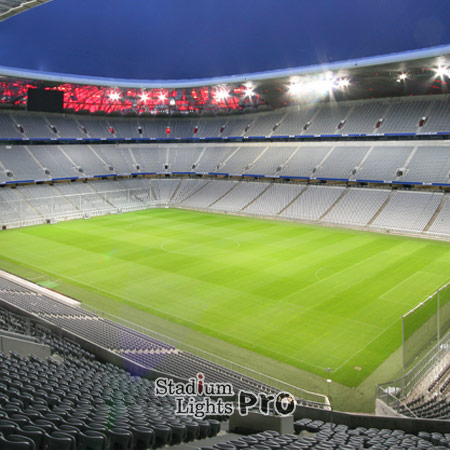 Illuminance is the measure of the amount of light falling on a surface, and it is crucial in providing proper visibility on soccer fields. Good illuminance levels on soccer fields enable players and officials to see the ball clearly, identify other players, and judge distances accurately. The level of illuminance can impact the safety of the players and the overall quality of game play.
Illuminance is the measure of the amount of light falling on a surface, and it is crucial in providing proper visibility on soccer fields. Good illuminance levels on soccer fields enable players and officials to see the ball clearly, identify other players, and judge distances accurately. The level of illuminance can impact the safety of the players and the overall quality of game play.
The required level of illuminance varies based on the level of play, ranging from recreational soccer to professional play. The Illuminating Engineering Society of North America (IESNA) has published recommended illuminance levels for various levels of play. For recreational fields, the recommended level is 50 footcandles (fc), while amateur fields should have an illuminance of 75 fc. Professional fields, on the other hand, require an illuminance of 125 fc. These levels take into account the visual needs of players, the size of the ball, and the speed of play at each level.
Large fields or stadiums require specialized lighting solutions to achieve proper illuminance levels. High mast lighting towers can be used to increase the height of the light source and provide uniform illuminance over larger areas. The towers can be fitted with LED or metal halide lights depending on the requirements of the field.
While high illuminance levels are desirable for players, it is essential to balance these levels with energy efficiency and cost-effectiveness. Modern LED lighting systems can provide high illuminance levels while consuming less energy and lasting longer than traditional lighting systems.
Lighting uniformity and glare control
Lighting uniformity is the measure of the consistency of illumination across a surface. It is essential for ensuring that all areas of the soccer field receive the same level of illumination. Uneven illumination can lead to poor visibility and create shadows that can affect the game play.
Glare is the excessive brightness that causes discomfort or impairs vision. It can be caused by light fixtures, reflections from the field surface, or other objects. Glare can affect player performance, especially when looking up to track the ball or move from dark to bright areas of the field. It can also cause discomfort for spectators, leading to negative experiences.
Lighting uniformity and glare control can be achieved through the proper selection of lighting fixtures, placement, and orientation. Uniformity can be improved by using multiple fixtures with overlapping illumination patterns. This will ensure that all areas of the field receive the same level of illumination. Glare control can be achieved by using shields, diffusers, or louvers to reduce the brightness of the light source and minimize reflections.
The use of modern LED lighting systems can also improve lighting uniformity and glare control. LED lights offer better control over the direction and intensity of the light, and can be dimmed or brightened as needed. They also have a longer lifespan and require less maintenance than traditional lighting systems.
Energy efficiency and sustainability
Efficient lighting can help reduce energy consumption and minimize costs while also reducing the environmental impact of the field. Inefficient lighting systems can consume a lot of energy and produce a significant amount of greenhouse gases.
There are several energy-efficient lighting options available for soccer fields, including LED, induction, and fluorescent lighting. LED lighting is the most popular option due to its high efficiency, long life, and low maintenance requirements. Induction lighting is also a good option as it has a long life span and is highly efficient. Fluorescent lighting is another option, although it is not as energy-efficient as LED or induction lighting.
Aside from using energy-efficient lighting, sustainable practices can also be employed to reduce the environmental impact of soccer field lighting. These practices include using renewable energy sources such as solar or wind power, recycling materials such as lamps and fixtures, and minimizing light pollution by directing light only where it is needed. Implementing these sustainable practices can reduce the carbon footprint of the lighting system and promote environmental stewardship.
Maintenance and durability
Proper maintenance is essential for ensuring the longevity and optimal performance of soccer field lighting systems. Regular maintenance can help to identify and address any issues before they become major problems, which can help to prevent costly repairs and replacements down the line. Additionally, maintenance can help to keep the lighting system running at peak efficiency, reducing energy consumption and costs.
Different types of lighting systems have different maintenance requirements. For example, LED lighting systems generally require less maintenance than traditional metal halide systems, as they have longer lifespans and do not require frequent bulb replacements. However, regardless of the type of lighting system, regular cleaning and inspection of fixtures, wiring, and other components is essential to ensure proper functioning and prevent damage.
The lighting system must be able to withstand various weather conditions, such as wind, rain, and extreme temperatures. Besides, the lighting fixtures must be able to withstand impact from soccer balls or other objects. Durability can be improved through the use of high-quality materials, such as impact-resistant polycarbonate lenses and weather-resistant coatings.
Cost considerations
The cost of soccer field lighting can vary greatly depending on the type of lighting system selected. Traditional metal halide systems tend to be less expensive upfront but have higher ongoing maintenance and energy costs. LED lighting systems, on the other hand, tend to have higher upfront costs but lower ongoing maintenance and energy costs. Other factors that can impact the cost of the lighting system include the size of the field or stadium and the complexity of the installation.
When selecting a soccer field lighting system, we may consider both the upfront costs and the long-term cost savings. While LED lighting systems may have higher upfront costs, they tend to have lower ongoing maintenance and energy costs, which can lead to significant cost savings over time. Furthermore, some energy-efficient lighting systems may be eligible for rebates or other incentives, which can further offset the initial cost.
Financing options can help to make the upfront costs of energy-efficient lighting systems more manageable. For example, leasing or financing options can allow facility owners to spread out the cost of the lighting system over time. Moreover, some energy-efficient lighting systems may be eligible for rebates or incentives from utility companies, government programs, or other organizations. These incentives can help to offset the initial cost of the lighting system and make it more financially feasible for facility owners.
Types of soccer field lighting systems
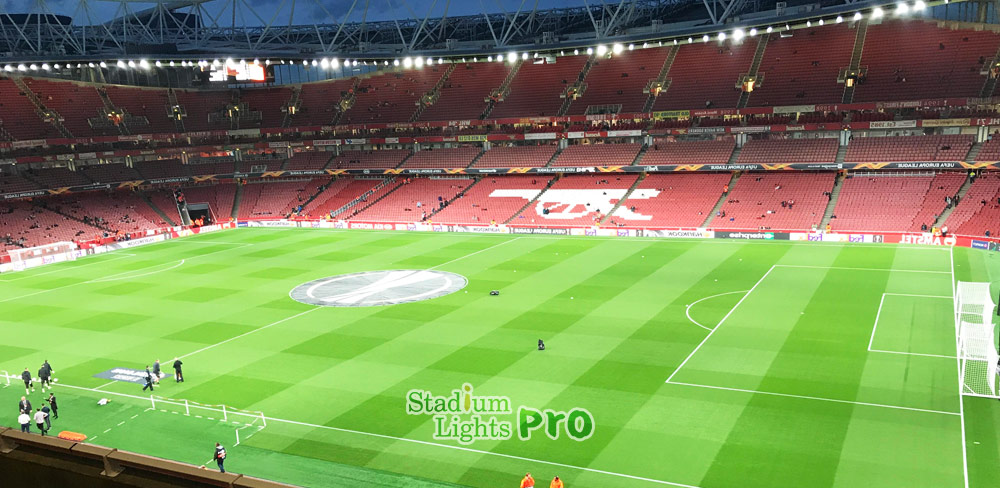
There are several types of soccer field lighting systems available, each with their own unique features and benefits. Understanding the differences between these systems can help facility owners and managers make an informed decision when selecting the best lighting system for their needs.
Metal halide
Metal halide lighting systems are a traditional lighting option for soccer fields. They are known for providing bright, high-quality lighting that can cover large areas. However, they are also known for their high energy consumption and ongoing maintenance costs. Metal halide systems also have a relatively short lifespan and require frequent bulb replacements, which can add to maintenance costs.
| Pros | Cons |
|
|
LED
LED lighting systems are becoming increasingly popular for soccer field lighting due to their energy efficiency and low maintenance requirements. LED lights consume less energy than metal halide lights and have a longer lifespan. They also provide better lighting uniformity and can be easily dimmed or turned on and off. LED lighting systems can have a higher upfront cost, but the cost savings in energy and maintenance costs over the lifespan of the system often outweighs the initial investment.
| Pros | Cons |
|
|
Induction
Induction lighting systems are similar to LED lighting systems in terms of energy efficiency and low maintenance requirements. They also have a long lifespan and can provide high-quality lighting. However, induction lighting systems are less commonly used for soccer field lighting due to their higher upfront costs.
| Pros | Cons |
|
|
Fluorescent
Fluorescent lighting systems are a less common option for soccer field lighting. They are known for being energy-efficient and providing high-quality lighting. However, they are also known for their shorter lifespan and ongoing maintenance requirements. Fluorescent lighting systems are also more commonly used for indoor sports facilities.
| Pros | Cons |
|
|
Installation and maintenance of soccer field lighting
Choosing the right installation team and contractor
Selecting the appropriate installation team and contractor for a soccer field lighting project is crucial to ensure that the lighting system is installed accurately and operates effectively. To make an informed decision, consider the following factors.
Experience and qualifications of the team
When planning to install a soccer field lighting system, one of the vital factors to consider is selecting a team that has experience in installing similar systems. A team with a track record of successful installations in the past is more likely to have the expertise and knowledge required to ensure that the lighting system is installed correctly and efficiently.
We need to verify that the team has the necessary qualifications and certifications to carry out the installation. This could include certifications such as the National Electrical Code certification or certification from lighting manufacturers. These qualifications ensure that the team has the skills and knowledge required to perform the job safely and efficiently, minimizing the risk of any installation errors or hazards.
Quality of work and references from previous clients
Selecting the right installation team is a critical step in ensuring the success of your soccer field lighting project. Before making a decision, we can review the team’s previous work to assess the quality of their workmanship. One way to do this is to ask the installation team to provide references from their previous clients. Contacting these references and asking about their experience with the team can provide valuable insights into their expertise, professionalism, and reliability.
We can consider the team’s qualifications and certifications. The team should have the necessary skills and knowledge required to install soccer field lighting systems. Look for certifications or licenses from relevant organizations or regulatory bodies to ensure that the team has met the necessary standards.
Cost and budget considerations
While it’s essential to stay within budget, we need to keep in mind the value of the service provided and the long-term cost savings that a quality installation can bring. A reliable installation team can help you choose the most cost-effective and energy-efficient lighting system that meets your requirements, reducing energy consumption and minimizing maintenance costs.
Timeline and project management capabilities
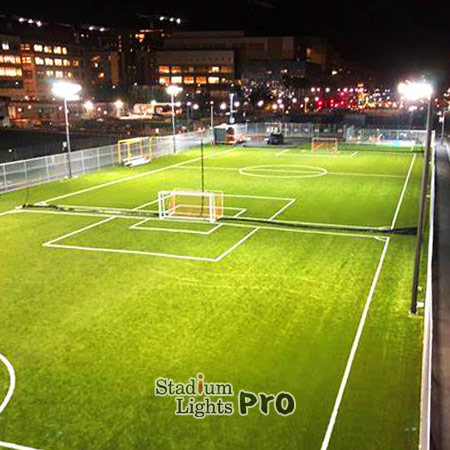 It is essential to have a realistic timeline for the installation service, and it should be within your project’s schedule. When selecting an installation team, you should consider their project management capabilities and their ability to deliver the project on time and within budget. A team that has a proven track record of managing similar projects can provide a smoother and more efficient installation process, reducing the risk of delays or cost overruns.
It is essential to have a realistic timeline for the installation service, and it should be within your project’s schedule. When selecting an installation team, you should consider their project management capabilities and their ability to deliver the project on time and within budget. A team that has a proven track record of managing similar projects can provide a smoother and more efficient installation process, reducing the risk of delays or cost overruns.
It is also recommended to discuss the timeline and project schedule with the installation team before hiring them to ensure that they can meet your project’s needs. The installation team should be able to provide a detailed project plan that outlines the timeline and milestones for the installation process, as well as a clear communication plan to keep you updated on the project’s progress.
Keep in mind that rushing the installation process to meet a tight schedule can compromise the quality of the installation and result in costly repairs or replacements in the future.
Communication and collaboration
It is essential to choose a team that can understand your needs and requirements and is willing to collaborate to ensure that the project meets your expectations. The team should have good communication skills and be able to provide regular updates and progress reports to keep you informed throughout the installation process.
Collaboration between the installation team and your team is also crucial to ensure that the lighting system meets the specific needs of the soccer field. The team should be open to feedback and willing to make adjustments based on your requirements. This can include adjusting the lighting levels or positioning of the fixtures to enhance player performance and safety.
The installation team should be willing to work with other contractors or teams involved in the project, such as electricians or field construction teams. Effective collaboration can help ensure that the project is completed efficiently and within the timeline and budget.
Proper maintenance procedures and schedules
Maintaining soccer field lighting is crucial for ensuring the longevity and efficient operation of the lighting system, as well as avoiding expensive repairs. To achieve proper maintenance procedures and schedules, consider the following tips.
Follow the manufacturer’s instructions
We need to carefully review the manufacturer’s instructions for maintaining and caring for the system. These instructions provide valuable guidance on how to keep your system running efficiently and effectively while also avoiding the risk of voiding the warranty.
Make sure to carefully read and follow the manufacturer’s guidelines on maintenance procedures, including cleaning instructions, replacement of bulbs or damaged parts, and regular inspections. They may also include recommendations for specific maintenance schedules and the use of certain cleaning products or tools.
Adhering to the manufacturer’s instructions can help prevent potential issues with the system, such as malfunctioning fixtures or wiring, which can lead to uneven lighting or even accidents on the field. It can also help you identify potential problems early on, allowing you to address them before they become more serious and costly to repair.
By following the manufacturer’s instructions, you can ensure that your soccer field lighting system operates efficiently and effectively for years to come, while also preventing the need for costly repairs or replacements.
Schedule regular maintenance
A maintenance schedule should include regular inspections, cleaning, and repairs. By conducting routine inspections, you can identify and address minor issues before they turn into costly and time-consuming problems.
When creating a maintenance schedule, we should consider the specific needs and requirements of your soccer field lighting system. The frequency of inspections and cleaning may vary depending on the type of fixtures, usage, and environmental conditions. It is recommended to have a professional conduct an annual inspection to ensure that the system is functioning correctly.
During inspections, the technician should check for any damage, malfunctioning fixtures or wiring, and signs of wear and tear. They should also inspect the electrical components, including the wiring and control systems, to ensure that they are in good working order. Any damaged or worn-out components should be replaced promptly.
Inspect the system regularly
Regular inspections of soccer field lighting systems are effective to detect any signs of damage or wear and tear. During inspections, the system should be thoroughly checked for any broken or missing lights, corrosion, or worn-out cables. If any of these issues are found, they should be addressed promptly to avoid further damage to the system.
For example, broken or missing lights can lead to uneven lighting on the field, which can be a safety hazard for players. Corrosion and wear on cables can lead to electrical issues or even a complete failure of the lighting system. These issues can be costly to repair and may also result in downtime for the field, which can impact scheduled games or events.
Inspections should be conducted regularly, and the frequency of inspections may vary depending on factors such as the age of the system and the amount of usage it receives. A professional lighting contractor can advise on the appropriate inspection schedule for your specific system.
Besides, it’s recommended to keep a log of all maintenance activities, including inspections, cleaning, and repairs. This log can help track the maintenance history of the system and identify any recurring issues or trends.
Clean the lights and fixtures
Dirt, dust, and debris can accumulate on the lights and fixtures, reducing their efficiency and output. Regular cleaning can help maintain their performance and extend their lifespan.
To clean the lights and fixtures, first, turn off the power to the lighting system. Then, use a soft cloth or a soft-bristled brush to remove any debris or dirt from the surface of the lights and fixtures. Avoid using harsh chemicals or abrasive materials, as they can damage the fixtures.
It is recommended to clean the lights and fixtures at least twice a year, or more frequently if the field is located in a dusty or dirty environment. Cleaning should be conducted before and after major events or games to ensure optimal lighting conditions.
Regular cleaning not only helps maintain the efficiency and output of the lights and fixtures but also enhances the appearance of the field, creating a more enjoyable experience for players and spectators alike.
Replace bulbs and fixtures as needed
To maintain a soccer field lighting system, it is crucial to replace any burnt-out bulbs and malfunctioning fixtures as soon as possible. This helps ensure even illumination across the field, prevents further damage to the system, and avoids safety hazards for players and spectators. It is recommended to keep a stock of spare bulbs and fixtures on hand for quick replacement.
We may also check the quality and compatibility of replacement bulbs and fixtures to ensure they meet the manufacturer’s specifications and provide the desired level of performance. Using subpar or incompatible parts can lead to lower efficiency, shorter lifespan, and potential damage to the system.
Regularly inspecting and replacing bulbs and fixtures can also contribute to long-term cost savings by avoiding larger and more costly repairs or replacements down the line. It’s essential to follow the manufacturer’s recommendations and guidelines for replacing bulbs and fixtures and to consult a professional if unsure or for more complex issues.
Use proper tools and equipment
When conducting maintenance on a soccer field lighting system, it’s suggested to use the proper tools and equipment to avoid causing damage to the system or compromising safety. Using the wrong tools or equipment can lead to stripped screws, broken parts, or even electrical hazards.
Ensure that you have the appropriate tools and equipment for the job, such as screwdrivers, pliers, wire cutters, and safety gear like gloves and goggles. Follow the manufacturer’s instructions for using any specialized tools or equipment that may be required.
What is more, we need to handle the lighting system with care during maintenance to prevent physical damage or mishandling of sensitive electrical components. Always handle the system gently and avoid any unnecessary force or pressure. If you’re unsure of how to perform a maintenance task, it’s best to consult with a professional to ensure that the job is done correctly and safely.
Train personnel
It is essential to provide adequate training to personnel responsible for maintaining the lighting system to ensure they have the necessary knowledge and skills to carry out their duties safely and effectively.
During training, personnel should learn about the manufacturer’s recommended maintenance procedures, as well as any regulations or guidelines specific to the lighting system. They should also be trained on how to properly use the tools and equipment needed for maintenance tasks to prevent damage to the system.
We shall provide personnel with the necessary tools and equipment to perform maintenance tasks safely and efficiently. This includes providing them with personal protective equipment, such as gloves and safety glasses, as well as any specialized tools or equipment needed for the task at hand.
Regular refresher training should also be provided to ensure that personnel remain up-to-date with the latest maintenance procedures and techniques. This can help to prevent accidents and ensure that the soccer stadium lighting system continues to operate safely and efficiently.
Upgrading and replacing older lighting systems
Upgrading or replacing older soccer field lighting systems can improve energy efficiency, reduce maintenance costs, and enhance the quality of lighting. Here are some tips to consider when upgrading or replacing your soccer field lighting system.
Evaluate the existing system
Upgrading or replacing an older soccer field lighting system requires a thorough evaluation of the existing system. This evaluation should determine the condition, performance, and energy efficiency of the current lighting system. Conducting such an evaluation is essential because it helps identify any issues that need to be addressed and determine the best course of action to take. For example, if the system is outdated and not performing efficiently, replacement may be the best option. However, if the system is still in good condition, upgrading the system may be sufficient to improve its performance and energy efficiency.
During the evaluation, consider factors such as the age of the system, its energy consumption, maintenance costs, and the level of illumination it provides. This information will help you determine whether an upgrade or replacement is necessary. If you decide to upgrade or replace the system, the information gathered during the evaluation will also help you choose the right type of lighting system that meets your needs and budget.
It is also recommended to consider any regulations or standards set by local authorities or sports organizations regarding lighting systems for soccer fields. These regulations may specify minimum levels of illumination or energy efficiency requirements that must be met. Make sure to comply with these regulations when upgrading or replacing your lighting system.
Set a budget
To upgrade or replace an older soccer field lighting system, we need to have a clear understanding of the budget required for the project. This includes considering the cost of the new lighting systems, installation costs, and any additional expenses such as permits and inspections. It is crucial to plan ahead and establish a realistic budget to avoid unexpected costs or delays in the project.
One approach to determining the budget is to conduct a cost-benefit analysis of the project. This involves weighing the costs of the new system against the expected benefits, such as increased energy efficiency and cost savings over the long term. It may also be beneficial to explore financing options or grants that may be available to offset the costs of the project.
We may consider the lifecycle cost of the new lighting system, which includes not only the upfront costs but also ongoing maintenance and operational expenses. A more energy-efficient system may result in cost savings over time, but may require a higher upfront investment.
Choose the right lighting system
To upgrade or replace your soccer field lighting system, we can conduct research and compare different lighting systems to determine the most suitable system for your needs. Consider factors such as energy efficiency, performance, durability, and maintenance requirements.
One essential aspect to consider is the energy efficiency of the new lighting system. Energy-efficient lighting can significantly reduce energy costs over time and also help to minimize the environmental impact of the lighting system. Look for systems that use LED lights, which are known for their high efficiency and long lifespan.
Performance is another crucial factor to consider when selecting a new lighting system. The system should provide sufficient illumination levels for the soccer field, with even distribution of light across the entire area. It is also required to consider the color temperature and color rendering index (CRI) of the lighting system to ensure optimal visibility and color accuracy.
Durability is also a key factor to consider, as soccer field lighting systems are exposed to harsh environmental conditions such as rain, wind, and extreme temperatures. Look for systems that are designed to withstand these conditions and are constructed with durable materials.
Maintenance requirements should also be taken into account when selecting a new lighting system. Look for systems that require minimal maintenance and are easy to service when needed.
Hire a qualified team
To upgrade or replace your soccer field lighting system, we should hire a qualified and experienced team of professionals who have a track record of successful projects and satisfied clients. This ensures that the installation is done correctly and efficiently.
Before hiring an installation team, we may research and compare different lighting systems to determine the most suitable one for your needs. This includes considering factors such as energy efficiency, performance, durability, and maintenance requirements. The cost of the new lighting system, installation costs, and any extra expenses such as permits and inspections should also be taken into account when determining the budget for the project.
After selecting a lighting system and installation team, it is vital to evaluate the existing system to determine its condition, performance, and energy efficiency. This will help identify any issues that need to be addressed and the best course of action to take. It may also be helpful to consult with a lighting design professional to ensure that the new system meets the required lighting standards and regulations.
Once the new system has been installed, we can conduct regular maintenance to ensure that it operates efficiently and lasts for its intended lifespan. This includes regular inspections, cleaning, and repairs. Proper maintenance not only helps detect issues early but also prevents major problems from developing.
Consider financing options
Financing options can help to offset the costs associated with the project and make it more financially feasible for your organization. Some financing options to consider include rebates, grants, and loans.
Rebates are offered by utility companies and other organizations to incentivize the adoption of energy-efficient lighting systems. These rebates can provide a substantial financial incentive to switch to more efficient lighting systems, and may cover a significant portion of the cost of the project.
Grants are another financing option to consider. Many government agencies and non-profit organizations offer grants to fund soccer field upgrades. These grants can be highly competitive, but can provide significant funding to offset the costs of your project.
Loans are also available to finance lighting upgrades. Some organizations may offer low-interest loans to help fund energy efficiency projects, and these loans can be repaid over a longer period of time, making the project more financially manageable.
When exploring financing options, we may research each option thoroughly to determine the eligibility requirements, application process, and potential benefits. Working with a qualified professional, such as a lighting consultant or energy efficiency expert, can also help you navigate the process and make the most of available financing options.
The impact of soccer field lighting on game play and safety
Improved visibility and player performance
Improved visibility due to effective soccer field lighting systems can lead to better player performance. With proper lighting, players can see the ball and other players clearly, allowing them to make better decisions and perform better on the field.
Apart from the ability to see clearly, appropriate lighting can also improve player safety by making it easier to avoid collisions and injuries. When players can see their surroundings properly, they can react quickly and avoid dangerous situations.
Effective soccer field lighting can also enhance the spectator experience by improving visibility and creating a more enjoyable atmosphere. Bright, even lighting can help fans see the action on the field and enhance their overall experience. With proper lighting, spectators can enjoy the game without straining to see the action, leading to a more satisfying and memorable experience.
Reduced risk of injury and accidents
Proper soccer field lighting not only enhances visibility and player performance, but it also helps to reduce the risk of injury and accidents. Poor lighting can create shadows and uneven lighting conditions, making it difficult for players to see obstacles and hazards on the field. This can increase the risk of collisions, falls, and other injuries.
Well-lit fields with proper lighting levels and even illumination can help players see the field and their surroundings clearly, reducing the likelihood of tripping, slipping, or colliding with other players. Besides, effective glare control can help players avoid temporary blindness caused by bright lights, reducing the risk of accidents.
Apart from reducing the risk of injury for players, proper soccer field lighting can also enhance safety for spectators and staff. Adequate lighting levels in parking lots, walkways, and other areas surrounding the field can improve visibility and reduce the risk of accidents or crime.
Enhanced fan experience and safety
Proper soccer field lighting not only benefits players, but it also enhances the fan experience and safety. Adequate lighting levels can create a more immersive and enjoyable experience for spectators, making it easier to follow the action on the field and follow the game.
Also, proper lighting can help to create a safer environment for fans, reducing the risk of accidents or injuries in the stands and surrounding areas. This includes adequate lighting levels in parking lots and walkways, as well as proper illumination of emergency exits and other safety features.
Bright lights and glare can be distracting and uncomfortable for spectators, making it difficult to fully enjoy the game. Properly designed lighting systems with glare control can minimize the impact of bright lights on the fan experience while still providing adequate illumination for the field.
Soccer field lights frequently asked questions
What are soccer field lights?
Soccer field lights are specifically designed to provide optimal illumination for soccer games and training sessions, ensuring that players can perform at their best regardless of the time of day or weather conditions. These lights are strategically placed around the field to ensure even and uniform lighting, minimizing shadows and providing clear visibility of the ball, players, and other critical elements of the game.
To achieve the optimal lighting levels required for soccer, lights are typically positioned on tall poles around the perimeter of the field. The height of the poles ensures that the light is distributed evenly across the playing surface, reducing the likelihood of shadows that can affect players’ visibility and performance. The lights are often equipped with advanced optics and reflectors to further enhance the even distribution of light across the field.
Soccer field lights are also designed to minimize glare and light pollution. Glare can be a significant problem for soccer players, particularly when playing at night or in the early morning or late afternoon when the sun is low in the sky. To reduce the risk of glare, soccer field lights are typically equipped with shielding or lenses that direct the light downward onto the field, rather than upward or outward where it can cause glare or light pollution.
Why do soccer fields need lights?
Soccer fields are designed to provide a safe and enjoyable environment for players of all ages and skill levels. To achieve this goal, soccer fields must be equipped with appropriate lighting that allows for play and training sessions to continue even after dark. Inadequate lighting can not only hinder performance but also pose safety hazards for players.
Soccer field lights are critical in enabling players to continue their activities long after natural light has faded. These lights provide the necessary illumination for players to see the ball, each other, and other critical elements of the game. By ensuring sufficient lighting, players can maintain their performance and minimize the risk of injury from tripping, collisions, or falls.
Adequate lighting also enhances the quality of play. Players can better judge distances, anticipate movements, and react more quickly with better visibility. Soccer field lights also help to minimize shadows that can interfere with play and impede player performance.
Inadequate lighting can also have negative effects on player safety. Poor visibility can increase the likelihood of accidents, especially when players are moving at high speeds. Besides, insufficient lighting can make it difficult for referees and officials to monitor games, potentially leading to errors or unfairness.
What is the ideal height for soccer field lights?
The ideal height for soccer field lights typically falls between 30 and 60 feet, with the exact height depending on the size and layout of the field.
The placement of the lights at this height ensures that the light is evenly distributed across the entire field. At this height, the lights can effectively cover the entire playing surface, minimizing the risk of shadows that can impede players’ visibility and performance. By illuminating the entire field uniformly, players can better judge distances, anticipate movements, and react more quickly, thereby enhancing their safety and performance.
Another crucial advantage of placing soccer field lights at this height is that it minimizes glare. When lights are placed too low, they can create unwanted glare that can be a significant problem for players, particularly when playing at night or in the early morning or late afternoon when the sun is low in the sky. Placing the lights higher helps to direct the light downward onto the field, reducing the risk of glare that can affect players’ visibility and performance.
However, the ideal height for soccer field lights can vary depending on factors such as the size of the field, the location of nearby buildings or trees that may impact lighting, and the specific lighting requirements for the facility. Therefore, it’s crucial to work with experienced lighting professionals who can assess the specific needs of your soccer field and recommend the best height and positioning for your lights.
What is the recommended wattage for soccer field lights?
When it comes to choosing the appropriate wattage for soccer field lights, several factors must be taken into consideration. The size of the field, the type of lights used, and the specific lighting requirements for the facility all play a crucial role in determining the optimal wattage.
In general, metal halide lights require more wattage than LED lights to achieve the same level of illumination. Metal halide lights produce a brighter, more intense light but are less energy-efficient than LED lights. LED lights, on the other hand, produce a more focused, directional light that requires less wattage to achieve the same level of brightness.
The recommended wattage for soccer field lights varies based on the size of the field. For a standard soccer field, a total wattage of 6000-10000 watts is recommended. However, larger fields or facilities with more complex lighting requirements may require higher wattage.
It’s worth noting that simply increasing the wattage of the lights does not necessarily result in better lighting. The type and quality of the lights themselves, as well as their positioning and distribution, all play a critical role in achieving optimal lighting levels. It’s essential to work with experienced lighting professionals who can assess the specific needs of your soccer field and recommend the appropriate wattage and lighting solutions to achieve optimal illumination for your facility.
What are the color temperature requirements for soccer field lights?
The recommended color temperature for soccer field lights is typically between 5000K and 6500K, which is considered a daylight or cool white color. This temperature range provides a clear and bright lighting environment, enhancing the visibility on the field and promoting better color rendering and contrast, which is essential for player performance and safety.
The cool white color of the light provides a more natural and vibrant lighting experience, making it easier for players to distinguish the ball and other players on the field. This improves the accuracy of passes and shots, reduces the risk of collisions, and enhances overall gameplay. The bright and uniform lighting provided by cool white lights helps players to stay focused and alert throughout the game, reducing the risk of injury due to poor visibility.
What is the average lifespan of soccer lights?
The lifespan of soccer field lights varies depending on various factors, such as the type of lights used, the frequency and duration of usage, and the quality of the lights.
Generally, LED lights tend to have a longer lifespan than traditional metal halide lights. The average lifespan of metal halide lights is typically around 15,000 hours, while LED lights can last up to 100,000 hours or more. This means that LED lights are often more cost-effective in the long term, as they require less frequent replacement and maintenance.
The lifespan of soccer field lights can be impacted by several factors, including weather conditions, the quality of the installation, and the frequency of maintenance and cleaning. For example, lights that are exposed to harsh weather conditions or installed in areas prone to flooding may have a shorter lifespan than those installed in more sheltered areas.
Regular maintenance and cleaning can also help extend the lifespan of soccer field lights. Proper maintenance and cleaning can help to prevent dust and debris buildup on the lights, which can reduce their efficiency and lifespan.
How much do soccer field lights cost?
Several factors can impact the cost of soccer field lights, including the type of lights used, the size of the field, and the installation process.
Generally, metal halide lights tend to be less expensive than LED lights. Metal halide lights can cost between $400 and $800 per light fixture, while LED lights can cost between $600 and $1200 per fixture. However, as mentioned earlier, LED lights tend to have a longer lifespan and are more energy-efficient, making them more cost-effective in the long term.
A larger field will require more light fixtures, which will increase the overall cost of the lighting solution.
The installation process can also impact the cost of soccer field lights. The cost of installation will depend on the complexity of the project, the equipment required, and the labor costs involved. It’s essential to work with experienced lighting professionals who can provide an accurate cost estimate based on your specific needs and requirements.
While the initial cost of soccer field lights may seem significant, investing in high-quality lighting solutions can offer long-term benefits, such as improved player safety, enhanced performance, and lower maintenance costs.
What is the recommended lighting level for soccer fields?
The recommended lighting level for soccer fields is generally at least 50 foot-candles, although some regulations may require higher levels. A foot-candle is a unit of measurement for the amount of light that falls on a surface. A lighting level of 50 foot-candles means that there is enough light to provide good visibility on the playing surface.
Yet, the lighting level required may vary depending on the specific needs of your facility. For example, if your soccer field is used for high-level competition, you may need to provide higher lighting levels to meet regulatory standards and ensure fair play.
The placement and distribution of soccer field lights can also impact the lighting levels on the playing surface. The lights should be strategically placed around the field to ensure uniform lighting and minimize shadows. The height of the lights can also impact the distribution of light on the field, and a height between 30 to 60 feet is typically recommended.
How are soccer pitch lights installed?
Installing soccer field lights is a complex process that requires specialized expertise in sports lighting. It’s highly recommended to work with experienced professionals who can ensure that the lighting system is installed correctly and safely.
The installation process for soccer field lights involves several steps. The first step is to assess the lighting needs of the facility, including the size of the field, the desired lighting levels, and any regulatory requirements. This information is used to develop a lighting plan that outlines the placement, height, and wattage of the lights.
Once the lighting plan is developed, the installation team will begin the physical installation of the lights. This process involves placing the lights on poles around the field at the predetermined locations and heights. The poles used to support the lights are typically made of durable materials, such as steel or aluminum, to withstand weather conditions and ensure the safety of players and spectators.
After the poles are installed, the lights are wired to a control panel, which allows operators to turn the lights on and off, adjust the lighting levels, and monitor the system’s performance. The control panel is typically located in a central location, such as a maintenance shed or control room, and can be accessed by authorized personnel.
Then, the installation team will conduct tests to ensure that the lights are functioning correctly and providing the desired lighting levels. Once the system is fully tested and approved, it can be put into regular use.
Can soccer field lights be dimmed?
Yes, it is possible to dim soccer field lights, and this can be an effective way to reduce energy consumption and adjust lighting levels based on specific needs. Dimming can be controlled manually, using a switch or a control panel, or it can be automated using sensors or timers.
Dimming soccer field lights can provide several benefits. For example, during warm-ups, players may not require the same level of lighting as during a competitive game. By dimming the lights during warm-ups, you can save energy and reduce costs while still providing adequate visibility for the players.
Dimming can also be useful after the game is over. Once the players have left the field, there is no need for the lights to remain at full brightness. By dimming the lights, you can save energy and reduce costs while still providing enough light for maintenance crews or other activities that may take place after the game.
Automatic dimming systems can be particularly effective because they can adjust the lighting levels based on specific conditions or events. For example, sensors can detect changes in natural light levels and adjust the artificial lighting accordingly. Timers can also be programmed to turn the lights on and off at specific times, ensuring that they are only in use when needed.
Are there any regulations or standards for soccer field lighting?
Yes, there are established regulations and standards for soccer field lighting, which are set by organizations such as the International Federation of Association Football (FIFA) and the Illuminating Engineering Society (IES). These standards provide guidelines for lighting design to ensure that soccer fields are adequately lit and safe for players, officials, and spectators.
The standards specify minimum lighting levels, uniformity requirements, glare control, and other factors that are critical to maintaining safety and performance on the field. For example, FIFA recommends a minimum lighting level of 2000 lux (approximately 186 foot-candles) for television broadcast quality and 500 lux (approximately 46 foot-candles) for recreational play. The IES recommends a minimum of 50 foot-candles for uniformity and visibility on the field.
Uniformity is also a critical factor in soccer field lighting. The lighting must be distributed evenly across the field to avoid shadows or dark spots that could affect player safety or performance. The standards also specify limits on glare, which can be caused by bright light sources or reflections on the playing surface. Glare control measures, such as shields or louvers, can help reduce the risk of eye strain or visual impairment.
Aside from these technical requirements, there may be local regulations and building codes that apply to the design and installation of soccer field lighting. These regulations can vary depending on the location and intended use of the field.
Can soccer field lights be used for other sports or activities?
Indeed, soccer field lights can be utilized for a variety of other sports or activities that demand high-quality lighting conditions, such as football, rugby, lacrosse, and ultimate frisbee. These lights are designed to provide uniform and consistent illumination across the playing surface, ensuring that players can perform at their best and enjoy optimal visibility.
Soccer field lights can also be repurposed for non-sporting events such as concerts, festivals, and other outdoor activities. The bright and reliable lighting provided by these fixtures can help create a safe and enjoyable environment for attendees, performers, and staff alike.
One of the benefits of using soccer field lights for non-sporting events is their versatility. The lights can be easily adjusted to accommodate different lighting requirements, such as changing the direction of the beams or dimming the lights to create a more subdued atmosphere. This flexibility makes soccer field lights an attractive option for event organizers who need a reliable and adaptable lighting solution.
While soccer field lights can be used for other purposes, it’s essential to ensure that any new use adheres to local regulations and safety standards. For example, if the lights are repurposed for a concert or festival, organizers must ensure that the noise level and crowd size are appropriate for the area and that the lighting meets any relevant codes or regulations.
How can I maintain my soccer field lights?
Proper maintenance helps to prevent premature wear and tear, reduce energy consumption, and minimize the risk of accidents or malfunctions. There are several maintenance tasks that should be regularly performed on soccer field lights to keep them in optimal condition.
One essential maintenance task is cleaning the light fixtures. Over time, dirt, dust, and debris can accumulate on the lights, reducing their illumination capacity and affecting their performance. Cleaning the fixtures can involve wiping down the lenses, removing any debris or obstructions from the bulbs or reflectors, and inspecting the surfaces for signs of damage or corrosion.
Another necessary maintenance task is to replace any damaged parts or bulbs promptly. Replacing bulbs can help to maintain the desired lighting levels and reduce energy consumption. Moreover, checking the wiring connections and conducting regular inspections can help to identify any issues early on, such as loose or damaged connections or signs of wear and tear on the light fixtures.
While some maintenance tasks can be performed by trained personnel or facility managers, more complex repairs or maintenance should be conducted by professional lighting contractors. A professional can provide expert knowledge and experience to ensure that the lights are functioning at their best.
Can solar-powered lights be used for soccer fields?
Although solar-powered lights have gained popularity for outdoor lighting due to their eco-friendliness, they may not be suitable for soccer fields due to the high energy demands of the sport. Soccer field lighting requires a consistent and strong source of illumination for extended periods of time, and the limited battery capacity of solar-powered lights may not be sufficient to meet these demands, especially during cloudy or rainy weather.
Furthermore, soccer fields typically require a high number of light fixtures, which can be challenging for solar-powered lights to supply the necessary wattage. As a result, traditional grid-powered lights are still the preferred option for soccer fields. However, advances in technology may make solar-powered lights more suitable for soccer fields in the future, and it is possible that we may see increased adoption of solar-powered sports lighting in the years to come.
What are some benefits of using LED lights for soccer fields?
LED lights have become increasingly popular for soccer field lighting due to several benefits they offer. One of the main advantages of LED lights is their higher energy efficiency. They consume significantly less electricity compared to metal halide lights, which results in lower energy bills and reduced environmental impact.
LED lights have a longer lifespan, typically lasting up to 100,000 hours, which means less frequent replacements and lower maintenance costs over time.
Apart from the cost savings, LED lights also offer superior lighting quality. They provide a higher color rendering index (CRI) than metal halide lights, resulting in more natural-looking light and better color accuracy on the field. LED lights also offer better control over light distribution, which allows for more even lighting across the field and reduces glare, improving visibility for players and spectators.
What are some common problems with soccer field lights?
Soccer field lights can experience several problems that may affect their performance and safety. One common issue is uneven lighting, which can result in areas of the field being poorly illuminated while others are too bright. This can be caused by the improper placement of lights, or incorrect height and angle of the light fixtures.
Another problem that can occur is glare, which can affect players’ visibility on the field and potentially cause eye strain or injury. Glare can be caused by the reflection of light on the field surface or other objects near the field.
Flickering lights can also be a problem, which may be caused by aging equipment or faulty wiring. This can result in reduced lighting levels or uneven illumination on the field.
Regular maintenance and inspections can help identify and address these problems. Maintenance tasks such as cleaning the fixtures, replacing bulbs, and checking wiring connections can prevent issues from arising. We may conduct regular inspections to identify any issues and ensure that the lighting system is functioning properly.
In some cases, the installation of the lights may need to be adjusted or replaced to address the issue. Besides, the use of lighting controls such as dimmers, timers, and sensors can help adjust lighting levels and minimize the problems of uneven lighting and glare.
Conclusion
Soccer field lighting is a critical aspect of creating a safe and enjoyable environment for players and fans alike. Adequate lighting levels, lighting uniformity, glare control, energy efficiency, maintenance, and cost considerations are all crucial factors to consider when selecting, installing, and maintaining soccer field lighting systems. Proper soccer field lighting can enhance player performance, reduce the risk of injury and accidents, and create a more immersive and enjoyable experience for fans. By choosing the right lighting system and ensuring proper installation and maintenance, soccer field owners and facility managers can create a safe and enjoyable environment for players and fans to enjoy the game.
We welcome any inquiries you may have about soccer field lighting and are happy to provide you with additional information. Our team offers a free lighting design and consultation service to help you select the right lighting system for your specific needs. We understand that each soccer field is unique, and we are committed to providing customized solutions that will enhance the safety and performance of players while improving the overall fan experience. Please do not hesitate to contact us with any questions or to schedule a free consultation. Our experts are ready to assist you in creating the best soccer field lighting system possible.

